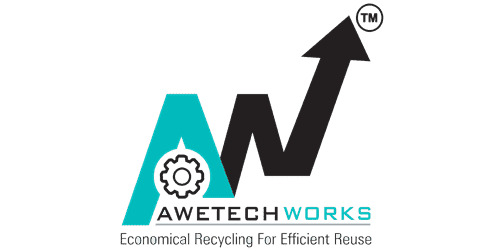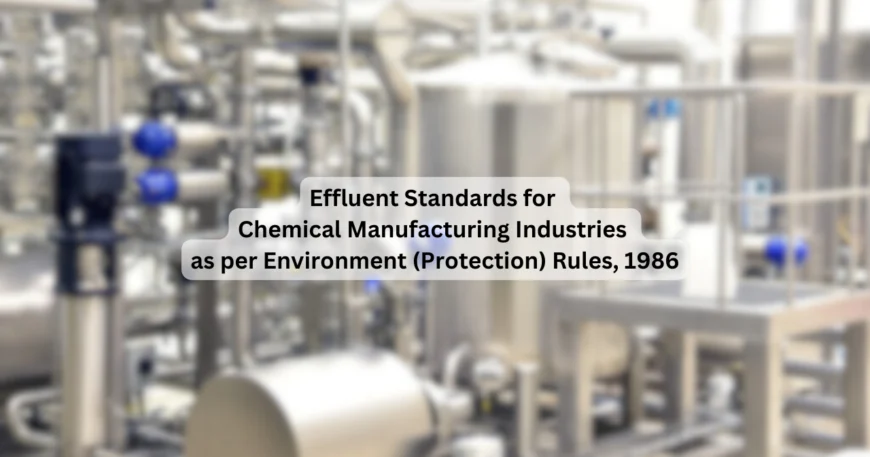Chemical manufacturing industries are vital to the global economy, producing a wide range of products, including fertilizers, pharmaceuticals, plastics, and industrial chemicals. However, these industries also generate significant amounts of wastewater and pollutants that can harm the environment if not managed properly. To address this issue, regulatory bodies have established effluent standards under the Environment (Protection) Rules, 1986, and other related laws. This article provides a detailed overview of the effluent standards applicable to chemical manufacturing industries, along with the necessary steps to achieve compliance.
Introduction to Effluent Standards
Effluent standards are regulatory guidelines that specify the maximum permissible levels of pollutants in wastewater discharged from industrial or commercial facilities. These standards are designed to protect water bodies, ecosystems, and public health by ensuring that harmful substances are not released into the environment. For chemical manufacturing industries, effluent standards are particularly important because these facilities generate wastewater containing toxic chemicals, heavy metals, acids, alkalis, and organic compounds.
In India, the Environment (Protection) Rules, 1986, and the Water (Prevention and Control of Pollution) Act, 1974, govern the discharge of effluents into water bodies. Chemical manufacturing industries are included in Schedule-I of the Environment (Protection) Rules, 1986, highlighting the need for stringent regulation of these facilities.
Key Pollutants Generated by Chemical Manufacturing Industries
Chemical manufacturing industries generate a variety of pollutants, including:
Toxic Chemicals: Acids, alkalis, solvents, and other hazardous chemicals are common byproducts of chemical manufacturing processes. These substances can be harmful to aquatic life and human health.
Heavy Metals: Activities such as metal processing, catalyst use, and raw material handling can release heavy metals like lead, mercury, cadmium, and chromium into wastewater. These metals are toxic and can accumulate in the environment.
Organic Compounds: Organic chemicals, including phenols, benzene, and toluene, are often present in wastewater from chemical manufacturing. These compounds can be toxic and difficult to degrade.
Suspended Solids: Particulate matter from raw materials, catalysts, and process residues can contribute to suspended solids in wastewater.
Biochemical Oxygen Demand (BOD) and Chemical Oxygen Demand (COD): Organic matter in wastewater can deplete oxygen levels in water bodies, affecting aquatic ecosystems.
Effluent Standards for Chemical Manufacturing Industries
The General Standards for Discharge of Environmental Pollutants (Schedule VI of the Environment (Protection) Rules, 1986) provide the baseline effluent standards for industrial and commercial establishments. The following table outlines the key parameters and their permissible limits for chemical manufacturing industries:
Parameter | Standard Limit |
|---|---|
pH | 6.5–8.5 |
Total Suspended Solids (TSS) | 100 mg/L |
Oil and Grease | 10 mg/L |
Biochemical Oxygen Demand (BOD) | 30 mg/L (5 days at 20°C) |
Chemical Oxygen Demand (COD) | 250 mg/L |
Heavy Metals (e.g., Lead, Mercury, Cadmium, Chromium) | As per specific limits (e.g., Lead: 0.1 mg/L, Mercury: 0.01 mg/L) |
Total Dissolved Solids (TDS) | 2100 mg/L |
Ammonical Nitrogen (NH3-N) | 50 mg/L |
Sulphide (as S) | 2 mg/L |
Phenolic Compounds | 1 mg/L |
Cyanide (as CN) | 0.2 mg/L |
Total Coliforms | 1000 MPN/100 mL |
Detailed Explanation of Effluent Parameters
pH (6.5–8.5) : The pH level of wastewater indicates its acidity or alkalinity. Effluents with extreme pH levels can harm aquatic life and disrupt the natural balance of water bodies. Chemical manufacturing industries must neutralize their wastewater to ensure it falls within the permissible range.
Total Suspended Solids (TSS) (100 mg/L) : Suspended solids include particulate matter from raw materials and process residues. High levels of TSS can clog waterways and harm aquatic organisms. Sedimentation tanks and filters are commonly used to remove suspended solids.
Oil and Grease (10 mg/L) : Oil and grease can form a layer on water surfaces, preventing oxygen exchange and harming aquatic life. Oil-water separators are essential for removing these substances from wastewater.
Biochemical Oxygen Demand (BOD) (30 mg/L) : BOD measures the amount of oxygen required by microorganisms to decompose organic matter in wastewater. High BOD levels can deplete oxygen in water bodies, leading to the death of aquatic organisms. Biological treatment processes, such as activated sludge systems, are used to reduce BOD levels.
Chemical Oxygen Demand (COD) (250 mg/L) : COD measures the amount of oxygen required to chemically oxidize organic and inorganic matter in wastewater. Advanced treatment methods, such as chemical oxidation, are used to reduce COD levels.
Heavy Metals (e.g., Lead: 0.1 mg/L, Mercury: 0.01 mg/L) : Heavy metals are toxic and can accumulate in the environment. Chemical precipitation, ion exchange, and filtration are commonly used to remove heavy metals from wastewater.
Total Dissolved Solids (TDS) (2100 mg/L) : High TDS levels can affect the salinity and quality of water bodies. Reverse osmosis and evaporation are used to reduce TDS levels.
Ammonical Nitrogen (NH3-N) (50 mg/L) : High levels of ammonical nitrogen can lead to eutrophication, a process that depletes oxygen in water bodies. Biological nitrification and denitrification processes are used to remove ammonical nitrogen.
Sulphide (as S) (2 mg/L) : Sulphides are toxic and can cause odor issues. Chemical oxidation and precipitation are used to remove sulphides from wastewater.
Phenolic Compounds (1 mg/L) : Phenolic compounds are harmful to aquatic life and human health. Activated carbon adsorption and chemical oxidation are used to remove these compounds.
Cyanide (as CN) (0.2 mg/L) : Cyanides are highly toxic and must be removed to very low levels. Chemical oxidation and precipitation are used to treat cyanide-containing wastewater.
Total Coliforms (1000 MPN/100 mL) : Coliforms are indicators of fecal contamination. Disinfection methods, such as chlorination and ultraviolet (UV) treatment, are used to reduce coliform levels.
Effluent Treatment Technologies
To meet the prescribed effluent standards, chemical manufacturing industries must implement appropriate treatment technologies. Some of the commonly used methods include:
Neutralization Tanks : Neutralization tanks are used to adjust the pH of wastewater by adding acids or alkalis.
Sedimentation Tanks : Sedimentation tanks allow suspended solids to settle at the bottom, making it easier to remove them from wastewater.
Oil-Water Separators : These devices separate oil and grease from wastewater using gravity or coalescence.
Biological Treatment Systems : Biological treatment systems, such as activated sludge and biofilters, use microorganisms to break down organic matter and reduce BOD and COD levels.
Chemical Treatment : Chemical treatment methods, such as coagulation, flocculation, and oxidation, are used to remove heavy metals, sulphides, and phenolic compounds.
Advanced Treatment Methods : Advanced methods, such as reverse osmosis, ultrafiltration, and activated carbon adsorption, are used to achieve higher levels of pollutant removal.
Zero Liquid Discharge (ZLD) Systems : In water-scarce regions, ZLD systems are used to treat and recycle all wastewater, ensuring that no effluent is discharged into the environment.
Steps to Achieve Compliance
Conduct an Environmental Impact Assessment (EIA) : Identify the potential environmental impacts of the facility and develop a plan to mitigate them.
Obtain Necessary Permits : Apply for and obtain environmental clearance and discharge permits from the State Pollution Control Board (SPCB) or Pollution Control Committee (PCC).
Install Effluent Treatment Systems : Install and maintain appropriate treatment systems to ensure that wastewater meets the prescribed standards.
Train Staff : Train staff on proper waste management practices and the operation of treatment systems.
Monitor and Report : Regularly monitor effluent quality and submit reports to the regulatory authorities.
Conclusion
Effluent standards for chemical manufacturing industries are essential for protecting the environment and public health. By implementing appropriate treatment technologies and adhering to regulatory guidelines, these facilities can minimize their environmental impact and contribute to sustainable development. Compliance with effluent standards not only benefits the environment but also enhances the reputation of the facility and ensures long-term operational success.






